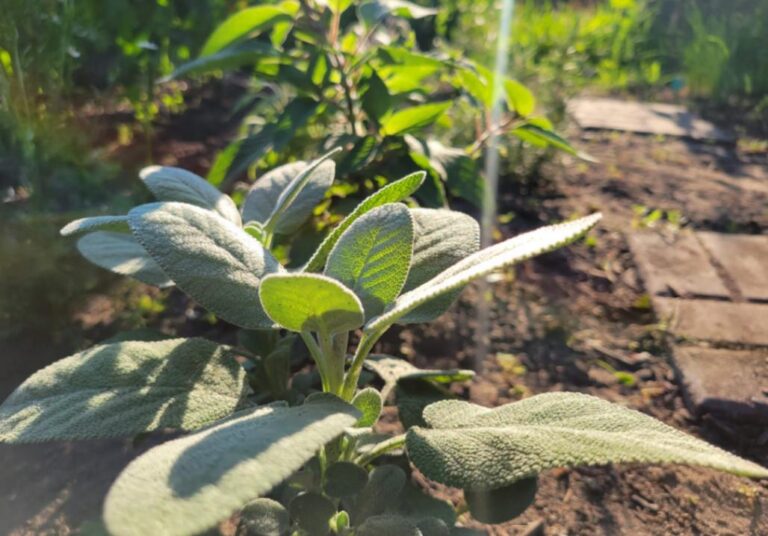This post may contain affiliate links which means I may receive a commission for purchases made through links. I only recommend products that I have personally used. As an Amazon Associate I earn from qualifying purchases. Learn more on my Private Policy page.
Sage, a hardy herb renowned for thriving in arid environments, has an exceptional ability to enhance the growth of various companion plants. Its affinity for dry conditions makes it an ideal ally for other herbs with similar water requirements.
Herbs such as oregano, rosemary, lavender, and thyme are all excellent herb companions with sage. Some great vegetable companions to sage include tomatoes, beans, carrots, and members of the brassica family like cabbage, broccoli, kale, and cauliflower. Sage also benefits strawberries when they are grown together.
Let’s explore the strategic practice of sage companion planting and the optimal partnerships that foster improved pest control, increased yields, and overall garden vitality.
Table of Contents
Best Herb Companions for Sage
One of the remarkable characteristics of sage is its ability to thrive in dry conditions. This makes it an excellent companion for other herbs that share similar water requirements. Oregano, rosemary, lavender, and thyme all grow well with sage due to their similar growing requirements and preference for drier conditions. Sage also works in combination with many of these herbs to boost pest control in your garden.
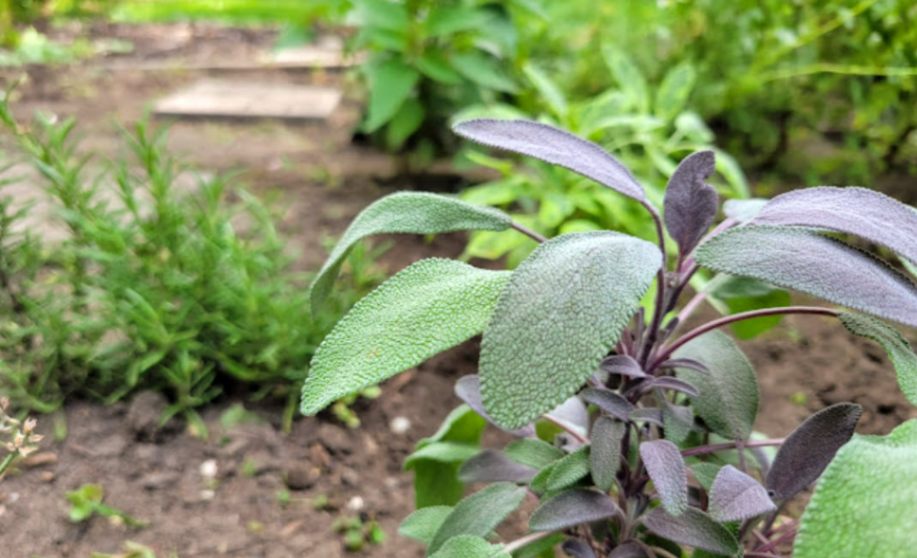
Oregano and Sage

Sage makes an excellent oregano companion plant. In addition to their similar water requirements, oregano and sage work together as natural pest repellents. These two herbs emit strong fragrances that help deter unwanted garden visitors like cabbage moths, carrot flies, and slugs.
Rosemary and Sage

Rosemary and sage both prefer well-drained soil and can withstand periods of drought. Their aromatic properties make sage and rosemary effective deterrents against various garden pests. By companion planting rosemary with sage, you’ll enhance the overall pest control capabilities in your herb garden.
Thyme and Sage

Thyme is well known for its ability to repel insects due to its strong scent. When companion planting thyme with sage, these two herbs complement each other to create a powerful insect-repellent defense system for your garden.
Lavender and Sage

Lavender and sage are both low-maintenance herb that thrives in dry conditions. They both prefer well-drained soil and can tolerate periods of drought. By companion planting lavender with sage, you can ensure they receive the appropriate amount of water without overwatering.
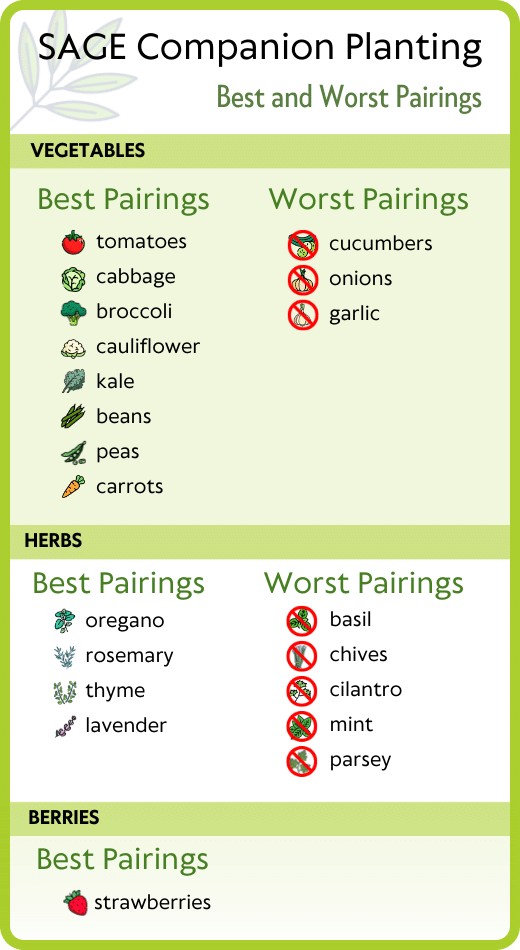
Tomatoes and Sage

Sage makes a good tomato companion due to its ability to draw in predatory insects, helping to control tomato pests like flea beetles and other harmful insects.
Sage Attracts Beneficial Predatory Insects
One of the key benefits of having sage in your tomato garden is its ability to bring in predatory insects. Sage attracts predatory insects that prey on common tomato pests, such as flea beetles and cabbage worms, keeping them in check naturally. When you plant sage with tomatoes, you create a favorable environment for these beneficial insects to thrive.
Sage Deters Pests That Affect Tomatoes
In addition to attracting predatory insects, sage also acts as a natural deterrent for pests that commonly affect tomatoes. Sage’s strong scent repels unwanted visitors like aphids and spider mites, which can cause a great deal of damage to tomato crops.
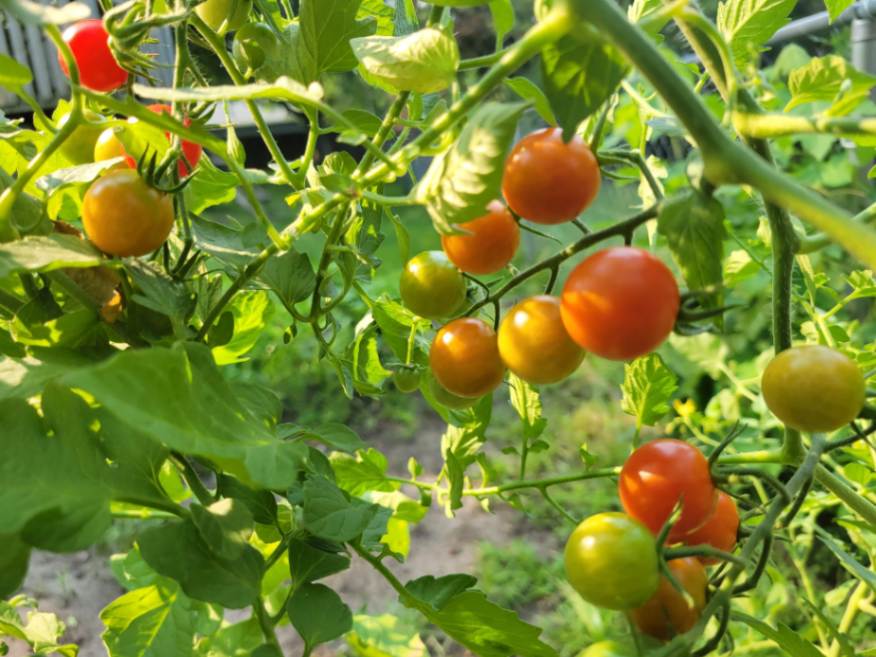
Tomatoes & Sage Have Different Watering Requirements
While tomatoes and sage make great companions in terms of pest management, it’s important to note their different watering requirements. Tomatoes generally prefer consistent moisture levels, while sage thrives in drier conditions.
To address this difference effectively, using containers when companion planting with sage can be a practical solution. By planting sage in containers alongside your tomatoes, you can more easily manage the watering needs of each plant individually. This allows you to provide ample moisture for the tomato plants without overwatering sage.
Brassicas and Cabbage Family

Brassicas like cabbage, kale, broccoli, and cauliflower can greatly benefit from sage companion planting. Sage acts as a natural repellent against cabbage moths and aphids, which are notorious for attacking brassica plants.
Defending Against Cabbage Worms with Sage
Cabbage worms, also known as cabbage loopers, feed on the leaves of cabbage family plants and cause significant damage. Sage naturally repels insects such as cabbage worms and aphids. By incorporating sage into your garden beds or containers, you can deter these pests from doing damage to your brassica crops.
Sage’s Defense Against Brassica Diseases
Sage is known to have certain antifungal properties that can protect brassicas from certain diseases such as clubroot, which causes stunted growth and wilting in cabbage family plants. The aromatic compounds found in sage have been shown to help combat clubroot and other fungal diseases.
Strawberries and Sage

Sage offers several benefits that can help protect strawberry plants from pests and promote their overall health.
Sage’s Pest-Repelling Shield for Strawberries
One of the main advantages of planting sage alongside strawberries is its ability to repel slugs, snails, and strawberry weevils. These common garden pests can cause a lot of damage to strawberry plants by devouring leaves and fruits. Sage’s pungent aroma acts as a natural deterrent to these visitors and can help keep them at bay.
Sage Attracts Beneficial Insects for Strawberries
Sage can also help to attract beneficial insects such as green lacewings, voracious predators of aphids, and other harmful pests that target berries. By supporting populations of green lacewings through sage companion planting, you create a natural defense system that helps maintain the health of your strawberry plants.
Shared Soil Requirements of Strawberries and Sage
Strawberries and sage both thrive in well-drained sandy soil. This shared requirement makes them compatible companions in terms of growing conditions. Their watering needs also align well since overwatering can be detrimental to both plants’ health.
Beans and Peas as Sage Companions

Beans and peas make great companions for sage. These plants have a mutually beneficial relationship that can enhance the health and productivity of both species.
Sage Keeps Pests Away from Beans and Peas
Sage emits a strong aroma that repels pests such as whiteflies, aphids, and thrips which are known to damage these legume crops. By planting sage alongside your beans and peas, you create a natural barrier against these pesky pests, reducing the risk of crop damage.
Beans Fix Nitrogen in the Soil
Beans and peas make excellent companions for sage due to their ability to fix nitrogen in the soil. Legumes have a unique symbiotic relationship with nitrogen-fixing bacteria present in their root nodules. These bacteria convert atmospheric nitrogen into a type of nitrogen that plants can utilize. Sage benefits from increased nitrogen availability as it requires adequate levels for optimal growth and development.

Sage Helps Attract Pollinators
Sage not only repels harmful pests but also attracts beneficial insects such as bees and butterflies, which play a crucial role in pollination, leading to improved fruit sets and higher yields. When these insects visit sage flowers for nectar, they inadvertently transfer pollen from the legume flowers as well, increasing the chances of successful pollination.
Carrots and Sage

Carrots and sage make excellent companions in the garden due to sage’s pest-repellent properties.
Sage Repels Carrot Flies
Sage is known to repel carrot flies, which lay their eggs on carrot roots leading to damage or rot. When planted near carrots, the strong scent of sage acts as a natural deterrent, making it less likely for carrot flies to infest your crop.
Sage’s scent helps to mask the smell of young carrots from other common garden pests as well. By camouflaging the scent of carrots with sage, you create an environment that is less attractive to these pests.
Poor Herb Companions to Sage
While sage makes a fantastic companion for various vegetables and herbs, there are several herbs that may struggle when grown in close proximity due to their different growth requirements.

Basil and Sage are not good garden companions. Basil prefers consistent moisture levels in the soil, while sage thrives in drier conditions. Companion planting basil together with sage can lead to conflicting watering requirements, making it challenging to maintain optimal growing conditions for both plants.

Cilantro and Sage will struggle when planted together. Sage prefers well-drained soil with minimal moisture retention, whereas cilantro enjoys most soil with more regular watering. The divergent soil needs of these two herbs make them less compatible as companions.

Chives and Sage also clash in their watering requirements. Chives prefer regular moisture levels in the soil compared to the dry conditions that sage favors. When planted together, these two herbs will struggle due to their disparity in watering needs.

Parsley and Sage have different growing requirements that make them ill-suited as companions. Parsley thrives best in rich soil with consistent moisture levels throughout its growth cycle. Sage prefers well-drained soil and drier conditions, making parsley companion planting with sage a bad combination.

Mint and Sage are poor garden companions due to mint’s invasive nature. Mint has a tendency to spread rapidly if not contained properly. Mint also prefers shade and regular moisture levels in the soil, which is contrary to sage’s preference for dry conditions. Mint companion planting with sage is not recommended.
Bad Vegetable Companions to Sage
While sage has many great companion plants in the garden, there are several vegetable plants that are not good companions to sage.
Cucumbers and Sage: A Moisture Mismatch

Cucumbers are a vegetable that does not fare well in close proximity to sage. While both plants thrive in full sun, their moisture requirements significantly differ. Sage prefers well-drained soil and can tolerate drier conditions, while cucumbers demand consistently moist soil for optimal growth. Planting them together may lead to an imbalance in soil moisture levels, negatively impacting both plants’ health. To ensure the success of your cucumber crop, it’s best to keep them away from sage.
Alliums: Not Compatible Growing Partners

Alliums such as onions and garlic are not ideal sage companion plants due to their incompatible growing conditions. Sage thrives in relatively dry soil conditions, whereas alliums prefer consistently moist soil throughout their growth cycle. Alliums also release certain compounds into the soil that can inhibit the growth of neighboring plants like sage.
Planting sage alongside alliums may also deter sage’s ability to attract helpful predators to your garden. To promote a healthy ecosystem and effective pest control, it is advisable to keep sage and alliums at a distance from each other.
Conclusion
In the realm of companion planting, sage stands out as a great companion plant, offering an array of advantages when grown in close proximity to certain vegetables and herbs. Through its pest-repelling properties, harmonious soil preferences, and remarkable ability to attract beneficial insects, sage plants can elevate the health and productivity of neighboring companion plants in your garden beds.
It is equally important to recognize the instances where sage might not be a good companion, as mismatched watering needs and growth preferences can hinder successful partnerships. By knowing how plants can benefit from sage companion plants and considering their limitations, gardeners can use this herb to cultivate thriving and harmonious ecosystems.
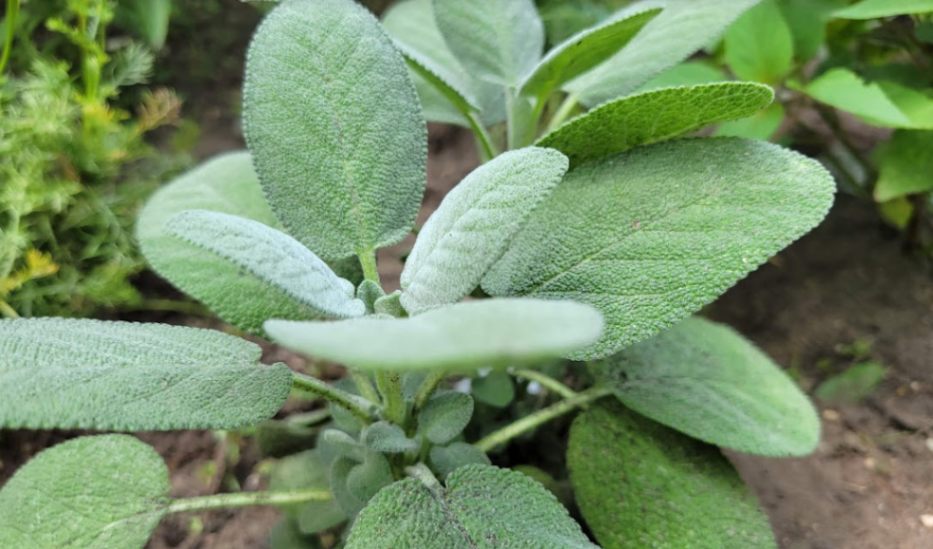
Frequently Asked Questions (FAQs)
What herbs grow well with sage?
Sage grows well with other drought-tolerant herbs such as oregano, rosemary, lavender, and thyme. These herbs all have a similar preference for relatively dry, loamy, well-draining soil. Many of these herbs also have mutually beneficial pest-repellent properties when grown alongside one another.
Can I grow sage near my tomato plants?
Tomatoes benefit from sage as a companion. Sage attracts predatory insects that combat tomato pests like flea beetles and cabbage worms. The scent of sage also wards off aphids and spider mites, helping to safeguard your tomatoes naturally. Due to competing water needs, consider companion planting sage in containers.
Are beans and peas good companions for sage?
Legumes such as beans and peas make great garden companions with sage. Beans and peas are nitrogen-fixing plants that enrich the soil with nitrogen, a nutrient essential for healthy plant growth. Sage benefits from this increased nitrogen availability while providing natural pest control against bean beetles.
Should I avoid planting certain herbs near my sage?
Avoid planting moisture-loving herbs such as basil, cilantro, chives, and parsley near sage. Sage prefers much drier conditions and should not be planted with herbs that have more regular watering requirements. You should also avoid planting mint near sage, as mint prefers shadier conditions and can be very invasive.
Can I grow cabbage near my sage plants?
Sage is a beneficial companion plant for members of the cabbage family (known as brassicas). This includes vegetables such as kale, broccoli, and cauliflower. Sage helps repel pests like cabbage moths which like to feed on the leaves of these plants.
Does sage grow well next to strawberries?
Sage is an excellent companion for strawberries. It deters pests like slugs, snails, and weevils with its scent. Sage also attracts helpful insects like green lacewings that prey on harmful pests. Both plants share similar soil and watering preferences, making them ideal companions for healthier growth.
Can carrots and sage be planted together?
Carrots and sage can be grown together without any issues. In fact, sage’s aromatic properties may even help repel carrot rust flies, which are common pests that affect carrot crops.
Last Updated on 25 September 2023 by Bob Lee

